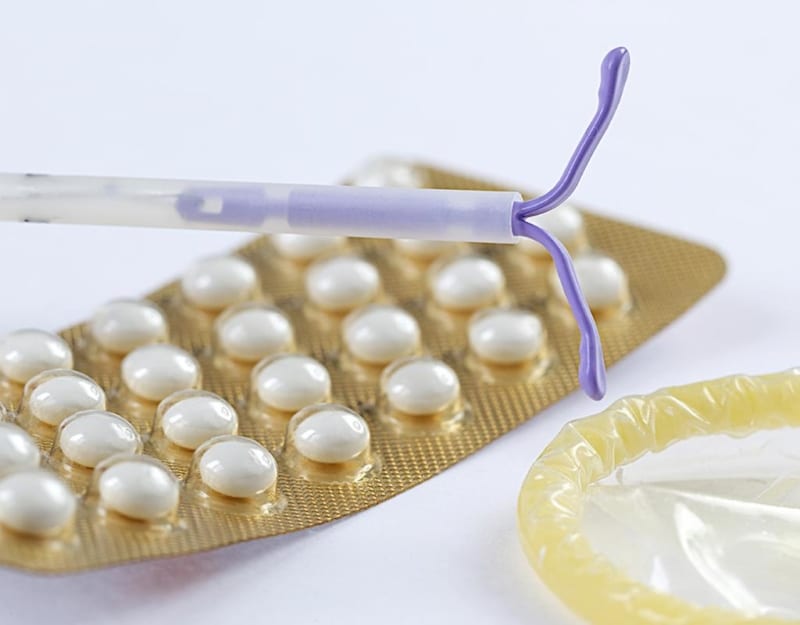In the days following the birth of your baby – especially if it is your first – you may find it difficult to imagine ever wanting to have sex again and contraception will, no doubt, be the last thing on your mind.
Despite what you may have heard – that breastfeeding is protection against pregnancy – note that it is not guaranteed. Plus, because your fertile time is two weeks before your period starts, and because your period may not return for between four to 10 weeks (often much longer), there is no reliable way to predict exactly when you will be fertile again.
It is a good idea to discuss contraception options with your GP at your 6-8 week check-up but if have sex before your next period arrives, it’s safest to use a simple method of contraception, such as a condom, until you and your partner come to a decision about long-term contraception for the future.
Contraceptive Choices
Combined Pill
This is over 99% effective and uses a combination of two hormones – progestogen and oestrogen – to prevent ovulation. It is not recommended if you are breastfeeding as it can reduce your milk flow.
Mini Pill
The progestogen-only version of oral contraceptive can be used while breastfeeding and is still 99% effective. It works by thickening the mucus at the entrance to the uterus – preventing sperm from entering.
Condoms
The easiest method for use soon after the birth as using condoms is as simple as remembering to keep a pack handy. To put your mind at ease, used properly, condoms are over 98 per cent effective.
Because many women experience dryness and discomfort after having a baby, it’s a good idea to use a lubricating jelly too – just make sure that it is water-soluble and won’t damage the condom.
An alternative to a regular male condom is a female condom – known in Australia as Femidom. It works by sitting inside the vagina, around the outside of the labia. If you have had an episiotomy during the birth, or have any tears or bruising, it may not feel comfortable. If used correctly, the female condom is around 95% effective but make sure that, during intercourse, the penis has entered your vagina into the condom, rather than between the condom and your vaginal wall.
Injections
If you don’t like swallowing tablets every day, or think that your busy schedule as a mother might make you forget to take it every 24 hours, an alternative to the pill is to have injections.
The injection works by releasing progestogen into the muscle over a period of weeks. Because it only lasts twelve weeks it is important to schedule an appointment for your next injection. Be aware that, although research has shown it doesn’t do any harm, small amounts of the progestogen hormone will be passed on to your baby if you are breastfeeding.
If you are planning a pregnancy in the future, note that, after stopping injections, it can take several months before your fertility is back to normal. Irregular bleeding is one possible side-effect.
Implants
Deciding to take this option requires careful consideration as implants offer a long-term contraception solution and can last for around three years – not the right choice if you are planning other children close together.
Under local anaesthetic, a small, thin plastic rod containing the hormone progestogen is inserted into your arm. In Australia, this is known as Implanon.
It works because the hormone is slowly released into the body, preventing eggs from being released, sperm from reaching an egg or an egg settling into the womb. Doctors claim that it won’t affect breastfeeding as only a small amount of the hormone goes through to your breast milk. It provides around 99% effectiveness and can be used about 6 weeks after your baby has been born. Not all doctors insert or remove implants so check with your GP before you make your appointment.
Be aware that the implant may shift, under your skin, from its original position. Using implants may cause your period to become irregular or stop altogether.
IUD or IUS System
An IUD is a small plastic and copper intrauterine device (commonly known as Multiload® in Australia), usually shaped like a ‘T’, that is fitted into the uterus by a doctor. The fitting of it will only take a couple of minutes and it can stay in place for up to five years.
The IUD has a fine nylon string attached to it which comes out through the cervix. The IUD works by preventing sperm from meeting an egg, or by preventing an egg settling in the uterus. IUDs can be used as an emergency method of contraception within five days of unprotected intercourse, or five days after expected ovulation.
The IUD may be fitted six weeks after having a baby (eight weeks if you had a caesarean) They are 98-99% effective.
In Australia, IUS is commonly known as Mirena – a small, plastic, T shaped device with a cylinder around its stem that releases the hormone levonorgestrel to prevent pregnancy. As it releases hormones, it is referred to as a system – different from the IUD which has no release of hormones.
Just like an IUD, though, the IUS is placed inside the uterus by a doctor and can stay in place for up to five years. Removal is relatively easy, due to the nylon string attached to it. At regular check-ups – initially at six weeks after insertion and then again at one year – the length of the string should be checked to make sure that the IUS has not shifted.
It is over 99% effective and, in some women, using IUS will cause ovulation to stop altogether.
Diaphragms
The diaphragm, or cap, is a circular dome made of rubber, which is fitted over your cervix before having sex. It acts as a barrier to stop sperm getting through to the uterus and should be used with either a spermicide cream, jelly or pessaries, which contain a chemical that destroys sperm. To use one for the first time, you will need to have it fitted by a doctor or nurse to make sure you have the size that’s right for you and some instruction on how to use it effectively.
The diaphragm does not affect your menstrual cycle and it may protect against cancer of the cervix. Like other barrier methods, you need only use it when you are sexually active.
The diaphragm must stay in place for six hours after sex and remember that, if you do have sex again before this time is up, you will need to insert more spermicide. For some women, spermicides may cause irritation or an allergic reaction.
If used correctly a diaphragm can be 92% to 96% effective.
Even though you may have been fitted for a diaphragm before, because having a baby may have affected the shape and size of your cervix, you should make an appointment with your GP to check and discuss before using again.
Natural Family Planning
No matter how accurate you believe your fertility charting to be, and how carefully you have pinpointed your fertile days, this is not a 100% reliable method of contraception and works best when trying to conceive, rather than trying not to.
With proper training from a natural family planning expert, though, it can be done and, if adhered to carefully, can be around 98% effective.
Female Sterilisation
This is performed by laparoscopic surgery, where a small incision is made in the lower abdomen in a position where any scarring will be virtually invisible. A portion of the fallopian tubes, which carry eggs from the ovaries to the uterus, are then either removed or clamped with a clip, preventing the sperm’s path to ever fertilising an egg again. Although the procedure only takes about 15-20 minutes, it does require a hospital stay and some recovery time. Like all surgical procedures, there are some small risks so be sure to ask your doctor to discuss these with you.
Female sterilisation is over 99% effective, does not interfere with sex and is free from hormonal side-effects.
Vasectomy (male sterilisation)
This is a permanent, surgical technique in which the vas deferens (the tubes that carry the sperm) are sealed – ensuring that no sperm are no longer present in semen when a man ejaculates.
Although sperm is still produced by the testicles, its passage to the penis is blocked and it is left to be reabsorbed by the body.
Having a vasectomy has no effect on orgasm, ejaculation, the production of male hormones or sex drive.
This procedure takes about 15-20 minutes and requires some special care in the days immediately following. Be aware that, because sperm can take a few months to disappear from the ejaculatory fluids completely, you should use another method of contraception (condoms) Done properly, it is over 99% effective.
Emergency Contraception
Had unprotected sex,? Had a condom come off or break during intercourse? To help avoid a pregnancy you might not be ready for just yet, ‘emergency’ contraception can be taken up to three days (72 hours) after sex. The earlier it is taken after the unprotected sex, the more effective it will be.
Some women experience side-effects, with the most common being nausea and vomiting. Breast tenderness, vaginal bleeding and headaches may also occur but are not as common.
This article was written by Claire Halliday for New Zealand’s leading pregnancy resource, Kidspot NZ.







Leave A Comment
You must be logged in to post a comment.